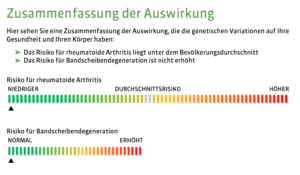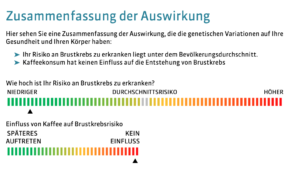HOW GENES INFLUENCE OUR HEALTH
A human body consists of approximately 50 trillion cells, and in most cells there is a cell nucleus in which the human chromosomes are embedded. A chromosome can be thought of as a “tightly wound thread”. The so-called DNA double helix.
Your DNA is your genetic code, i.e. the blueprint of your human body. In your case, this genetic code consists of about 3.2 billion letters and about 1% of this code represents the areas we call genes. A gene is an instruction for the body and usually has only one specific function. That is why someone has blue eyes and another has brown . There are also genes that tell the body how to break down food in the intestines to then absorb the nutrients.
Unfortunately, as unique as our genetics make us, our genes are not flawless. Each of us carries certain genetic defects or gene variations that we either inherited from our parents or that formed by chance and now negatively affect our health. These gene variations are very common and are usually just simple letter changes in the genetic code. The different variations weaken our immune system, increase our risk of heart attack, or give us bad eyesight. Of course, each of us carries different variations, which means that some people have a higher risk of heart attack and others cannot tolerate lactose, for example. Diseases clustered in certain families. As part of each individual analysis, we have had each gene studied for you and have summarized the most important scientific content for you in the categories below.
The scientific publications on which the analyses are based can also be found at the end.


BEYOND DNA WEIGHT - THE SCIENCE OF GENES.
The scientific basis for this gene analysis is unusually strong. On the one hand, the relevant genes have already been studied in more detail in numerous studies (more than 7500 studies for the PPARG gene, 167 studies for the FABP2 gene, 6897 studies for the ADRB2 gene and 493 studies for FTO). The weight analysis is based on the most important 53 studies on weight loss and nutrition.
Analyzed in this analysis are 8 polymorphisms that have different effects on the body. Since this is a very large analysis product, this description focuses only on the most important statements.
These are:
- People respond differently to dietary fat content due to genetic polymorphisms. It makes sense to adjust the fat content.
- People respond differently to carbohydrate content in the diet. Adjustment of carbohydrate content is reasonable.
- Genetic polymorphisms influence the body’s response to exercise.
- Genes influence the success of calorie reduction on weight loss.
Legend = Your personal analysis result (marked with an X)
GENOTYP = The different variants of the gene (called alleles)
POP = Percentage distribution of the different genetic variants in the population (population)ERG
RESULT POSSIBILITIES = Influence of the genetic variation
Weight loss programm
BEYOND DNA MY VITAMINS - THE SCIENCE OF GENES.
Beyond DNA MY Vitamins – A micronutrient blend specially formulated for you according to your genes to enhance your innate strengths and balance your weaknesses. Each Beyond DNA MY Vitamins sachet is uniquely formulated for you. There are more than 700 trillion different genetic profiles, only one of which fits you. Each person has different strengths and weaknesses and needs an individual supply of vitamins and trace elements. Take your personal micronutrient blend to give your body what it needs.
BEYOND DNA MEDICATION - THE SCIENCE OF GENES
How drugs work in our bodies
Everyone reacts differently to medications, and while some derive significant benefit from drug treatment, adverse side effects can cause severe complications and even fatal consequences in others. It is estimated that about 7% of hospital patients experience serious side effects and about 0.4% of you die as a result. Drug side effects are the fifth leading cause of death in the Western world and a large proportion of these cases are due to drug intoxication. Another portion is triggered due to the effects of drugs on each other, known as interactions.
When a drug is swallowed or injected with a needle, it first enters the bloodstream, through which it is transported to the target organ. The drugs are then recognized by an endogenous enzyme and prepared for degradation from the bloodstream, where most drugs lose their effect.
The deactivated drug is then filtered out of the blood by the kidneys and ultimately
and ultimately excreted in the urine

Long-term drug therapy
Because many medications should work for a long period of time, they are taken regularly to keep the amount of effective drug in the right range.
In this way, the drug always stays at the right dosage to have its intended effect.
Genetic defects delay the breakdown of the drug
Unfortunately, many people have a genetic defect in one of the enzyme genes that play an important role in this process. In this case, the drug still ends up in the bloodstream and shows its effect, but it is not prepared for degradation and remains in the body much longer. This is hardly a problem when taken once, but if the drug is taken 3 times a day, the concentration in the blood increases until toxic side effects occur.
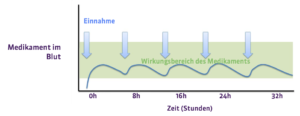
The problem with repeated use when a genetic defect is present
In the case of certain blood thinners, the blood thinning is initially in the right range, but if the drug is taken continuously, the concentration of the drug continues to increase, showing more and more blood-thinning or anticoagulant effects, until uncontrollable bleeding occurs.
This means that for 20% of the population carrying a genetic defect, a much lower dose of the drug is necessary, as the usual dose would lead to severe side effects.
Pro-drugs, the precursor to active drugs
Some drugs, called “pro-drugs,” are taken in an inactive form and converted to the active form by the body’s enzymes. Examples of such drugs are the cancer drug tamoxifen and the painkiller codeine. When such a drug is ingested, it enters the bloodstream, where it is then converted to the active form and produces its desired effect. The painkiller codeine is converted in this way into morphine, which has a pain-relieving effect.
However, if the enzyme gene is defective, the body cannot convert the drug into the active form and the drug thus shows no effect, but very much side effects.
In the case of codeine, pain relief does not set in after administration and the patient must switch to another drug.
However, in the case of Tamoxifen, a drug that prevents the development of breast cancer, the lack of effect of the drug is not noticeable and one is not aware of it until metastases develop.
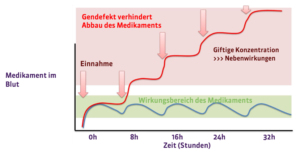
Evaluation of medications
Using the Beyond DNA Medication analysis, we gain insight into the status of your drug metabolism genes and can assess how the degradation and activation pathways of the various drugs are affected in you. From this information, medications and active ingredients were individually assessed for you in 3 categories (effect, degradation, dose). This information will help your doctor in the correct selection and dosage of your medication. A simple symbolism shows you how the effect, the degradation or the dose of the active substance is.
You can find an excerpt here:

BEYOND DNA HEALTH - THE SCIENCE OF GENES
The human body consists of about 50 trillion individual cells, and in most of these cells there is a cell nucleus containing the human chromosomes. A chromosome consists of a “tightly wound thread” called the DNA double helix.
The DNA is the actual genetic code, i.e. the blueprint of the human body. In every human being, this genetic code consists of about 3.2 billion letters and about 1% of this code represents the areas we call genes. A gene is an instruction for the body and usually has only one specific function. For example, there are genes whose function is to tell the body how to produce blue dyes, which then lead to blue eyes. There are also genes that tell the body how to break down food in the intestines so that it can then absorb the nutrients.
Unfortunately, our genes are not flawless and each of us carries certain gene defects or gene variations that we either inherited from our parents or that formed by chance and now negatively affect our health. These gene variations are very common and are usually just simple letter changes in the genetic code. The different variations weaken our immune system, increase our risk of heart attack, or give us bad eyesight. Of course, each of us carries different variations, which means that some people have a higher risk of heart attack and others cannot tolerate lactose, for example. Diseases clustered in certain families are a good example of how individual disease risk can vary from family to family and person to person.
These gene variations can influence our health, but in many cases they do not represent absolute facts of getting a disease, only an increased risk of disease. Whether the disease breaks out depends on external influences and lifestyle. For example, if a person cannot tolerate lactose due to a genetic variation, this person is perfectly healthy as long as he or she does not consume any dairy products. Complaints only arise when certain environmental influences occur, in this case lactose intake through food. It is the same with other diseases. For example, if an iron absorption regulation gene is defective, this increases the risk of iron storage disease, and a precautionary lifestyle is necessary to prevent the disease and perhaps prevent it altogether.
Experts estimate that each person carries about 2,000 gene defects or gene variations, which in total affect his or her health and body and in some cases cause disease. A variety of influences can cause changes in our genes (also called mutations), which in rare cases can have positive effects, but most often disrupt the function of the gene and negatively affect our health.
The most well-known cause of genetic defects in the media is radioactivity, whereby radioactive rays penetrate cells and damage our genetic code and thus, by chance, our genes.
Another cause of mutations and genetic defects are certain substances, such as polycyclic aromatic hydrocarbons, which are found, for example, on grilled food. They also enter cells and damage our genes, which can lead to colon and some other cancers. UV radiation from the sun also damages our genes, leading to diseases such as skin cancer.
These influences can alter individual genes and disrupt their function throughout our lives, but we inherit the majority of our gene variations from our parents. Each embryo receives half of the father’s genes and half of the mother’s genes when the egg is fertilized, which together create a new human being with some of the characteristics of each parent. With these genes, unfortunately, genetic defects are also passed on, and so it happens that, for example, a polymorphism that causes heart attacks is passed from father to son and on to grandson, leading to the disease in each generation. However, whether the genetic defect is passed on is determined by chance, and so some of the grandchildren may carry the genetic defect and others may not.
In this way, each person is unique and through the accumulation and combination of the different genetic variations, each person has different inherited health weaknesses but also strengths. With the latest technology, it is now finally possible to examine one’s own genes and read from them which very personal health risks exist. With this knowledge, preventive measures can then be taken and diseases prevented in many cases. This is the next step in preventive medicine and a new generation of health care.
Action Need Overview
The Beyond DNA Health analysis provides you with an overview of which genetic diseases may pose a risk to you. However, it is essential that lifestyle and nutrition have a positive or negative influence on the onset of diseases. Here you can see an excerpt of an evaluation:
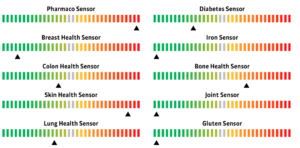
Risks that are in the orange/red area should be discussed with your doctor. The other areas do not show a generally increased risk and, provided there is no disease, do not require any special action.

You can see an excerpt of the detailed evaluation here:
